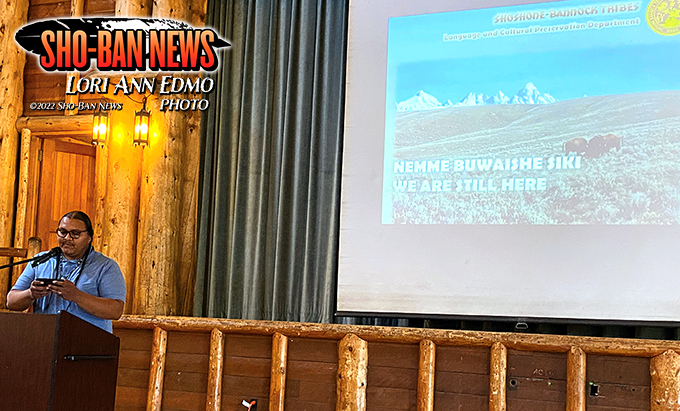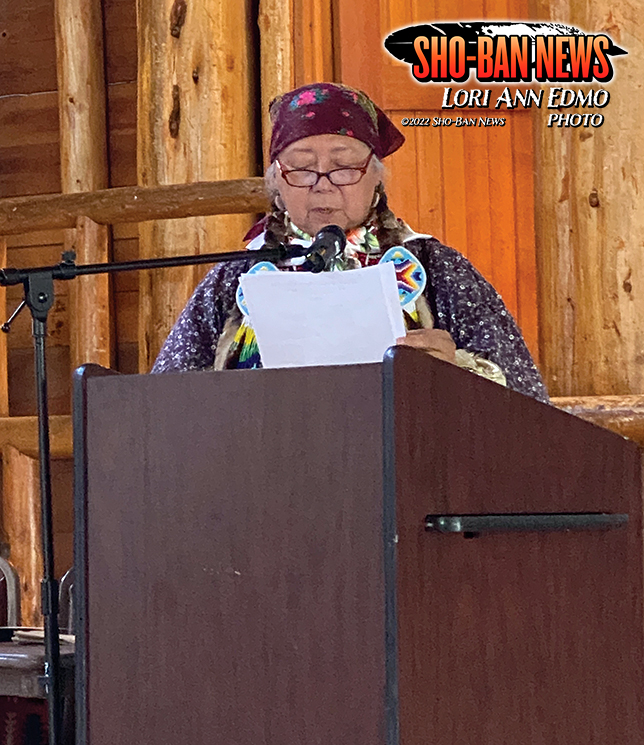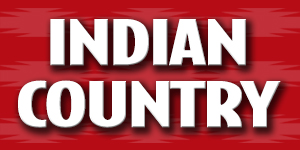Shoshone-Bannock tribal presence in Yellowstone National Park

LCPD Original Territories & Historical Researcher Nolan Brown presentation.
By LORI ANN EDMO
Sho-Ban News
OLD FAITHFUL, Wyo. — Nemme Buwishe Siki – We Are Still Here was the topic of Nolan Brown, Shoshone-Bannock Tribes Historical Researcher in the Language and Culture Department, presentation at the Tribes Yellowstone 150 Anniversary event where he talked about the long term interpretive vision.
He said the program hopes to increase tribal members and the general public’s awareness about the Shoshone-Bannock Tribes history and continued presence in all of Tribes original territories.
Brown presented a number of slides in a PowerPoint presentation including one about seasonal rounds in the Shoshone language that shows the system of survival the Tribes used to sustain us. It includes the central things our tribal people care about including water, air, fire, Mother Earth, “things sacred to us, we strive to protect,” that is broken down by seasons, Brown continued. A seasonal round in the Bannock language is also being completed.
He showed a slide about bison anatomy in the Shoshone language that explains about the parts of the sacred animal — many are in Yellowstone National Park.
Brown noted our people have a lot of history in YNP showing the map of the Bannock Trail, “for thousands of years our people traveled these areas, gathered obsidian at Obsidian Cliff,” a resource gathered and traveled far and wide. He talked about the various gahni - structures the tribal people utilized. A photo was shown from 1871 of Tukudika or Sheepeaters who inhabited the park. The Bannock Trail went through Camas Prairie, Boise Valley, Blue Mountains and down to California. He explained the Bannock War ended in September 1878 on the Clarks Fork Yellowstone when Col. Miles apprehended Bannock warriors who were then imprisoned Camp Brown in Fort Washakie, Wyo.
Brown also talked about the Sheepeater War that occurred in 1879 showing a photo of Chief Tendoy and family that also had Warjack pictured who was involved in the war. He also discussed the Jackson Hole War resulting in the Ward v Racehorse case in 1894 when outfitters and guides wanted to have the only access to the game around Yellowstone and Grand Teton -wanting to exclude Native people. John Racehorse Sr. was set up to be a test case involving the treaty rights of our tribal people. It went to the Supreme Court where it was determined our Fort Bridger Treaty rights were no valid because of the creation of the state of Wyoming. It has since been overturned in other cases. “We were excluded from our own homelands in areas reserved by treaty,” he said. He noted soldiers were brought to remove our people out of the park but we are still here.
He addressed the various Shoshonean treaties and called attention to the Virginia City Treaty that outlines the mixed bands of Shoshones and Bannocks including the Agai Deka (salmon eaters) and Tukudika (sheepeaters).
Brown said the plan is to have long range interpretive signs in all the Tribes original territories would be for years to come because the areas are vast. He showed a variety of images from Grant Teton, East Fork Salmon River, City of Rocks, Camas Prairie and Sawtooth National Recreational area where relationships are being strengthened. The Tribes are also involved the replacement of derogatory names where at least 60 Shoshone and Bannock names have been recommended to replace them.
Shoshone & Bannock Presence in YNP
Carolyn Boyer Smith, Cultural Resource Coordinator, said Shoshone-Bannock tribal elders consulted with YNP officials in 2002 and 2003, when Jeanette Wolfley and Gail Martin prepared an original ethnographic report. It shares stories from elders, the document offers the relationship and the landscapes tied to Shoshone and Bannock people who had a good feeling about being in the park. She shared words her late mother Merceline Bel Boyer said about the Park. She said a journey today for some tribal members into the Park could be for spiritual enrichment.
Shoshone-Bannock presence is documented in several ways first based on oral traditions of the tribe — the greater Yellowstone area is the origin and creation area of the Shoshone people so considered a sacred landscape of the people that is verified by the continuing cultural knowledge of place names and uses of resources in the Park by Shoshone and Bannock tribal members. There are many stories relating to Creation, formation of water ways such as the Snake River and other resources connected to the Park.

Cultural Resource Coordinator Carolyn Boyer Smith speaks.
She explained the Fort Bridger Treaty of 1868 secured the Tribes a permanent homeland the Fort Hall Reservation in Idaho and the Wind River Reservation in Wyoming. And the Treaty with the Shoshone, Bannock and Sheepeaters in 1868 and cession agreement of 1870 recognized the occupation of our people in the Park and Grand Teton areas. The Tribes reserved off reservation hunting, fishing and gathering rights in the Fort Bridger Treaty and secured our continued rights in and near the Park.
Smith talked about the Virginia City Treaty with the Mixed Bands of Shoshone, Bannocks and Sheepeater signed September 24, 1868. Officials wanted Chief Tendoy’s band of Shoshone and other Shoshone, Bannock and Sheepeaters to cede their claim to Montana lands including lands that would later became Park lands. It was never ratified by Congress so the Shoshones and Sheepeaters would remain in the Park area. In 1870, the U.S. and Territory of Montana signed a cession agreement to detail the expansive territory of Tendoy’s people and remove them to the Salmon River territory in present day Idaho. It encompassed about 9 million acres of land including the lands that formed Yellowstone and Grand Teton National Parks. Their aboriginal ownership of the land was never extinguished by Congress.
She said today there are a variety of cultural resources, including water, earth, plants and medicines, along with animals and mountains used by tribal members. The cultural landscape areas and resources have multiple values and uses that often overlap. Some areas are utilized more than others for gathering, sacrament or spiritual areas, or historical use such as trails. Spiritual places are often isolated areas where individuals stop to pray, leave offerings, do vision quests and offer respect.
Smith said it’s important to recognize the Shoshone and Bannock people view the region as culturally powerful in interconnected with many other areas used by the Tribes.
Plants were used for food, medicinal and spiritual wellbeing. Many plants are still collected in or adjacent to the Park. Some believe the plants in the Park are purer and have more power than those outside the area. Tribal field trips identified many species that were or still collected in and adjacent to the Park. Tribal elders recognize the role the Park plays in preserving and protecting the plants but many don’t understand the various laws that say the Park “owns” the plants and resources therefore prohibiting the gathering of plants for traditional cultural practices.
She explained Shoshone and Bannocks relied exclusively on plant foods to supplement the wild game in their traditional diet. Resources such as berries, edible roots, greens pine nuts, seeds and bitterroot were collected in the Park. She said tobacco plant could be found growing around Obsidian Cliff and Sheepeater Cliff. The late Alfred Navo noted tobacco represents the outdoor fire of our ancestors and is known to carry our prayer upward to the Creator. Tobacco is also used as an offering when the prayer of forgiveness is done.
Smith said bitterroot is also an important crop for the Tribes and continues to be used. Berry picking included sarvis, currents, strawberries in the valley and lower slopes, chokecherries and huckleberries in higher elevations. Leaves, bark, roots and pitch from a wide variety of plants were gathered. These plants were used to treat bruises, cuts, sores, infections, headaches and toothaches. A prayer of forgiveness was always given at the time of plant gathering.
She explained the importance of Obsidian Cliff as a primary source of obsidian for Shoshone and Bannock people – a primary stop over or camping area for hunting parties. It would be gathered for summer and fall buffalo hunts as a supply for knives, arrows and scraper for the hunt. The late Walter Nevada said the place is where the old people traveled and camped all through history. His mother told him they use to travel across from the Salmon River area to the Park and camp there. The late Alton Bear also said Sheepeater and Obsidian Cliff areas are the old campsites of the Salmon eaters – the old people said all through the rocky area.
Smith further talked about the geysers for medicinal and healing.
She explained Shoshone and Bannock people lived in what is now the Park lands for millennia. She said the taking of original lands had a devastating impact on our people’s lives, traditions and well-being. “Yet the memories and stories of our ancestral stories remain and have been passed onto the next generation which continues to strengthen cultural identity.”
It is hoped Yellowstone Park officials begin to understand, recognize and respect the world views of the Shoshone and Bannock peoples and the relationship to the Park area she continued. “One hundred fifty years is a very short period in the thousands of years of Shoshonean and Bannock presence in the Park.”
Velda Racehorse, talked about the Sheepeaters, Bannock and Shoshoni’s in Aboriginal Territory. She played the audio of Bannock elder Louida Ingawanup Unger telling the story of the Old Lady and Coyote in the Bannock language on how the Snake River was formed and other dams. She also presented a PowerPoint presentation that included when the Park was created, 82 families were removed from the area by 1872. She also discussed the Yellowstone family who lived in the area near the geysers. She explained about the Tribes relationship to the buffalo, the buffalo’s migration to the Yellowstone area and the extinction of the food source.
Fort Hall Business Council Chairman Nathan Small thanked everyone for attending and said basically what people heard is, “We lived here before and we continue to live here today in our minds and spirit by us returning to this land all the time. We have never left this place – we will never leave this place. It’s too important for our people to forget. It’s too important for our young people to forget.”
He said a lot of people came here today – a lot of our presenters talked about their experience and they also talked about what was told to them. They came here and shared those stories. If you listen to those stories you will repeat those stories to your young people and to others. “This is how we continue to live – this is how we are going to continue to remember. Like everyone was sharing 150 years is a very short time compared to the time we lived here for thousands and thousands of years. We want to continue to live here for thousands of years.”
Small said, “We may not be able to put up a house, we may not be able to put up a tipi, we may not be able to come here and live but it’s still our land. We’ve never left it. We share it now with the United States and we share it now with the world.”
“This land here is something special worldwide and this is our land – we are part of it and we care. And as indicated earlier with the Yellowstone staff and park superintendent and everybody they say welcome home and that’s where we are at today,” Small concluded.





